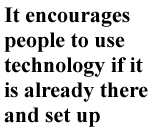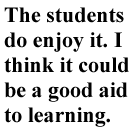



Case Studies
|
USER FEEDBACK
User feedback AV/IT
Perhaps surprisingly, staff normally use the equipment in the way that was intended
(though there have been some developments that reflect wider advances in
presentation techniques). The fact that most lecturers now use a PC has created an
increase in demand for IT facilities. When the theatres first opened, there was one
PC moved around all 5 theatres. This has increased to 4 used extensively for PC
based teaching, access to the Internet and for video conferencing.
(Very few people use 35mm transparencies, unless the subject specifically requires
the highest image quality available - such as architecture and medical courses).
Most people use Microsoft PowerPoint, with a few using Toolbook. The specific
requirements and specialties of different faculties are reflected in the usage of the
theatres. The faculty of Information & Engineering Studies tends to be at the
forefront of the use of technology in presentations, and staff use 'true' multimedia
presentations very regularly.
Easy access to a variety of presentation techniques has encouraged staff to use them
- and presentation styles have varied and improved significantly. (Many staff have
spoken of a sharp rise in ratings for their lectures when they began to use the new
theatres!)
BOUQETS & BRICKBATS
The following quotes from staff reflect real satisfaction and occasional frustration :
"It was great to find myself no longer handwriting OHP slides, or even photocopying
them onto acetate. I could go with a floppy disc in my back pocket and do the
presentation. Now I don't even need a floppy disc, because I can attach to the
network and retrieve all my material."
"Its a waste of a resource just to give slick looking PowerPoint presentations. It could
and should, be used more for video conferencing, and for networking between lecture
theatres to lecture to large numbers".
 "It encourages people to use technology if it is already there and set up" "It encourages people to use technology if it is already there and set up"
"I'm using it slightly less than I used to. The problems I've had are that I'm not
particularly technical, and when you're going to give a lecture, you're inevitably a
little bit hyped up anyway, and so if you're also having to deal with equipment, then
sometimes you gauge it wrongly."
"It wasn't so much using the software, we were already familiar with that, it was the
specifics of what the theatres will do. Like getting the right light button. Even now,
you can hit the wrong light button - the students like that!"
"So I think that my plea is that the machinery should be the same in every room, for
the benefit of those less confident with equipment. My plea is for consistency even
down to the laptops"
 "Since installation most lecturers have found the intercom system indispensable -
although some staff still prefer to go and find the technician in person."
"Since installation most lecturers have found the intercom system indispensable -
although some staff still prefer to go and find the technician in person."
"One drawback is that demands for assistance tend to come 'on the hour' when there
is a changeover in every theatre. This means that the technician is stretched during
the time that their service is required most."
"I have used the intercom in the past, not regularly, but when you've got 200 students
waiting for a lecture, then it's significant. It doesn't happen often but it's so important
to have that facility. I suppose it would be better if the button was on the desk. I
always say, 'Big Mac and fries please.'"
"You pressed one button, and several things happened at
once. That took a bit of believing, but once they got used to the fact that it did
happen, then they became very confident in it."
"Its good that the PC just does plug in, and then literally one button brings the screen
on. And also when you finish, one button turns it all off again".
User feedback Design and architecture
"Its a comfortable area for students, much better than packing them in."
"The way the lecture theatres are structured does not really lend themselves to
student interaction or small group sessions. In the course of the standard lecture, for
example you might want to just put a problem up, and let students talk among
themselves, for five or ten minutes and then reconvene. The lecture theatres do not
really facilitate this kind of flexibility in teaching."
"Partly due to the timetabling system- if you want to chat with the students
afterwards to pick up any questions, its out in the corridor. What would be good is
an area, like a seminar room. which could be an overspill for 15 minutes after the
lecture. "
"The students do enjoy it. I think it could be a good aid to learning. I think a course
could be run for those of us have been using it at one level, to bring us up to another
level of using it."
"I think its very good that all the technology is hidden and unobtrusive, its as
transparent to the
user as possible."
The circulation which was an important aspect of the design- enter from the back-
leave through the front is not always adhered to. Students instinctively go out the
same way as they came in. This creates a significant health and safety problem
unless clear signage and reminders from staff are in place. The stairs along the rake
are clearly not designed to be wide enough for students going up and down at the
same time.
"Even at the front row you're not craning you neck to look at the screen. And there's
enough writing room, they're not cramped up."
"'You can lead lectures in an ideal space. There is no comparison between that and the
other teaching rooms in the university."
User feedback- External clients
"We've got the advanced motorists, and the RAC coming up in the next few
weekends, and they are people who've used it a lot before and they are well pleased
with it. There are also large medical conferences held in the summer"
User feedback- Porters and cleaning staff
It takes three porters about forty minutes to pull out/ push in the retractable seats.
From the point of view of staff time, this is quite a costly exercise. An electrically
operated device could have shortened the process considerably.
The design of the theatre seating seems to have created a situation where students
can conceal and leave behind litter in the rows, eating and drinking in the lecture
rooms, despite signs prohibiting this. This causes mounting debris in the theatre, as
there is no timetabled cleaning between lectures. Therefore, every effort has been
made to deter users from leaving behind litter.
One issue is of over-crowding. Porters have been asked for extra chairs when a
theatre has been booked which is too small for the audience. Extra loose seating
would be a contravention of the health and safety regulations.

|


